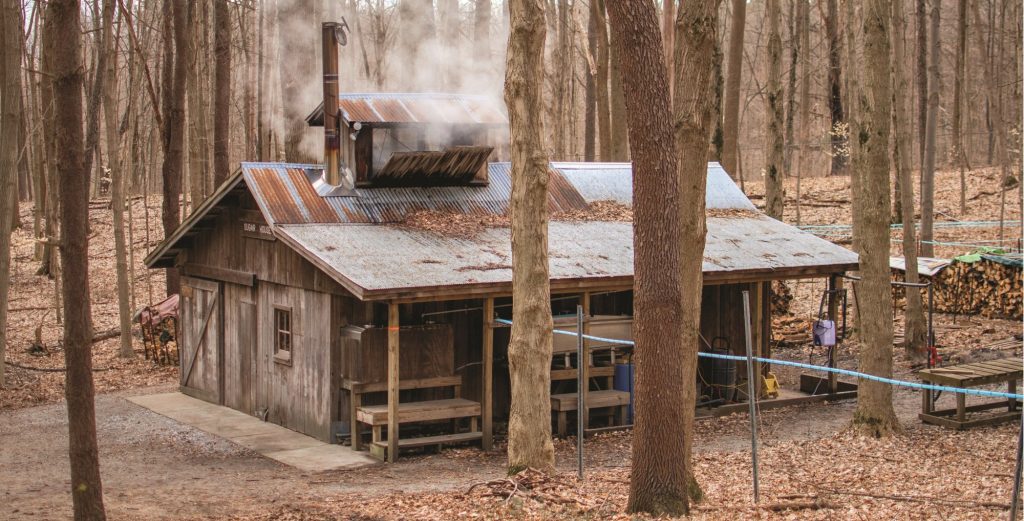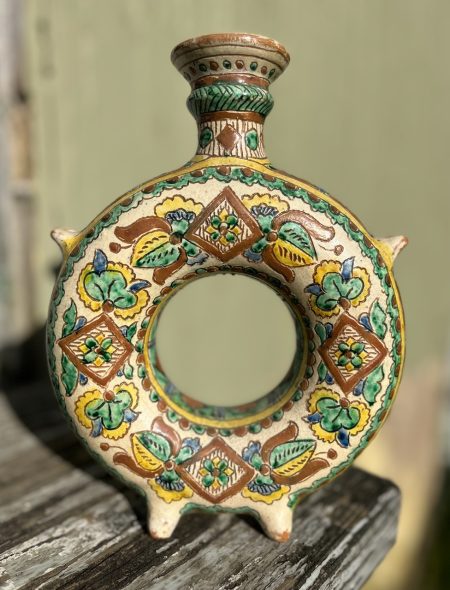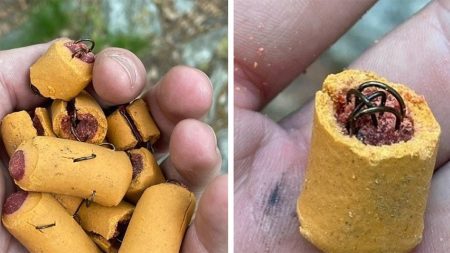It is one of the sweetest times of the year. Why? It is maple sugaring month. Although we associate maple with autumn, this is the time when the hard work happens at sugarhouses.
The sap starts to flow from sugar-maple trees when days are warmer and nights are still cool. The back-and-forth change in temperature is needed to create the required pressure.
When I visited a sugarhouse in the Catskill Mountains of New York to get a gallon of syrup, it was not the production time. However, the owner gave me a quick tour of the facility, and I got to see the advanced equipment. I will be going back, as it is common for sugarhouses to invite visitors to see the seasonal process in action.
The complex steps lead to a delicious, natural sweetener. For these rural producers, there are economic advantages where sugar maples are plentiful. If you have not been to a festival celebrating maple sugaring month, do attend one. It’s enjoyable for the whole family.
Enjoy the rural, natural setting while learning about the different grades and tasting both syrups and maple-flavored treats. I even sweeten my morning coffee with the liquid amber gold. Supporting local agriculture and small business is the cherry on top!
You have probably heard of wine, beer and distillery trails. Well, Pennsylvania has a trail called “Tapped: A Maple Trail.” Check it out at https://bit.ly/48Yk0ty.
Check out these links for more maple sugaring events: https://bit.ly/2CrHpXO and https://bit.ly/3wNW5Q7.
Maple syrup 101
• It takes about 40 gallons of sap to make 1 gallon of maple syrup.
• It comes in color-based grades.
• Canada is the largest maple producer in the world, followed by the United States.
• Vermont is the largest producer in the United States, producing more than 2.55 million gallons of syrup in 2022. This represents more than half of the output in the U.S., followed by New York, Maine, Wisconsin, Michigan, Pennsylvania and New Hampshire.
• According to PA Route 6 Alliance, Patterson Maple Farm in Westfield, Tioga County, is the largest maple producer in the state with 83,000 taps.
• Maple syrup production occurs in a brief period, usually about 40 days, based on the weather.
• A maple tree is usually at least 30 years old and 12 inches in diameter before it is tapped.
• Use maple syrup to sweeten your coffee or tea. It is packed with antioxidants and minerals.
• Breweries are using maple syrup as an ingredient to create beer.
• According to Wikipedia, “Maple syrup was first made by the Indigenous people of North America.”
Cooking with maple syrup
People enjoy cooking with maple syrup for several reasons: the flavor, nutritional/health benefits, versatility and natural sweetness. When I say maple syrup, I mean the real thing, not the high-fructose, corn syrup laden product with artificial coloring and many hard-to pronounce chemical-sounding ingredients.
I cannot explain why some people think that “imposter” syrup is the real thing, or worse yet, think it tastes like maple syrup. When visiting my parents and we go out for breakfast, they often order pancakes and request sugar-free pancake syrup. Yes, I cringe, knowing the not-so-good ingredients it contains. I appreciate it when a restaurant does have maple syrup, the real thing, even if they have an upcharge for it.
There are many books written about maple sugaring, becoming a backyard hobbyist, the science and history, and cooking with maple syrup. Think beyond just pancakes!
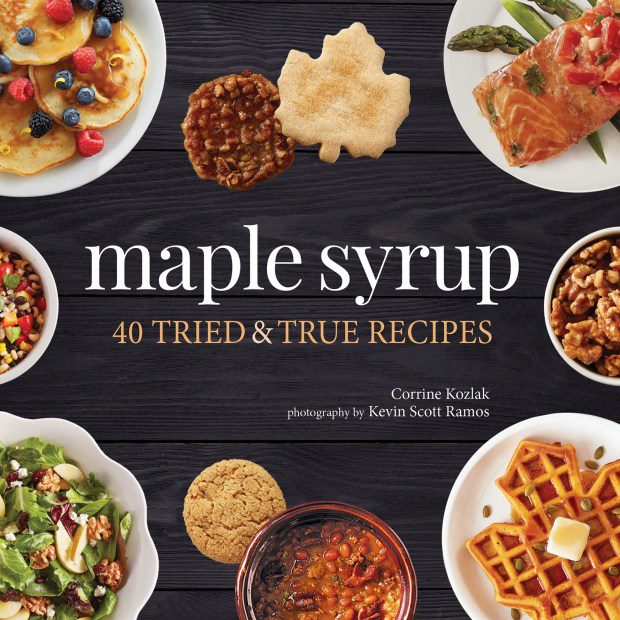
“Maple Syrup: 40 Tried & True Recipes,” by Corrine Kozlak (2020, Adventure Publications, $16.95), https://bit.ly/3sOYSTR, goes beyond just recipes. Kozlak provides a short history of maple syrup and discusses how it is made and graded.
And, if you have access to a sugar maple that is at least 12 inches in diameter, the “Do-It-Yourself Maple Syruping or Backyard Sugaring” pages tell you what equipment is needed, plus when and how to tap the trees, as well as how the sap becomes syrup.
The maple syrup cooking tips will be helpful. There are recipes for bread and breakfast, savory entrees, sides, appetizers, and beverages as well as sweets and desserts.
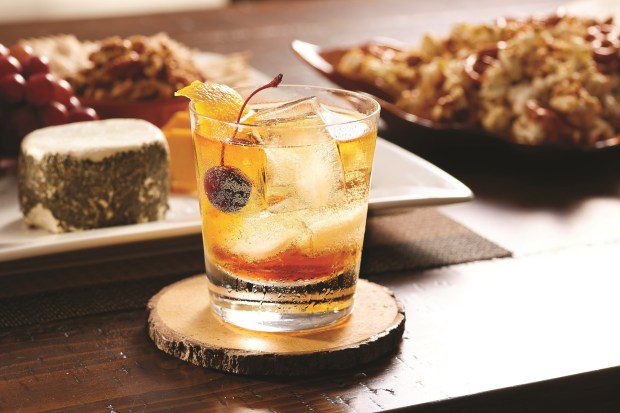
Celebrate Maple Sugaring Month and prepare a recipe shared by Kozlak. For the recipe for Maple Leaf Cocktail, visit https://bit.ly/3Vl2IDo.
Best Basic Buttermilk Pancakes
Makes 12–16 pancakes
Ingredients:
2 cups all-purpose flour (gluten-free flour may be substituted)
2 tablespoons sugar
2 teaspoons baking powder
½ teaspoon baking soda
½ teaspoon kosher salt
2 cups buttermilk
2 large eggs
2 tablespoons butter, melted and cooled
1 tablespoon lemon juice
Vegetable oil
Toppings: softened butter, warm maple syrup, fresh fruit
Directions:
In a large bowl, mix together flour, sugar, baking powder, baking soda, and salt; make a well in the center of the mixture.
In a large glass measuring cup, mix buttermilk, eggs, 2 tablespoons melted butter, and lemon juice to combine. Pour buttermilk mixture into the well of the flour mixture; gently mix. (A few lumps are wanted.) Let batter rest 10 minutes.
Heat griddle to 375 degrees or a nonstick pan to medium-high heat. Add a thin layer of oil and butter to the hot surface. Pour ¼ cup batter onto griddle for each pancake; cook until top is bubbly and edges are slightly dry, about 2 to 3 minutes on each side. Serve hot with desired toppings.
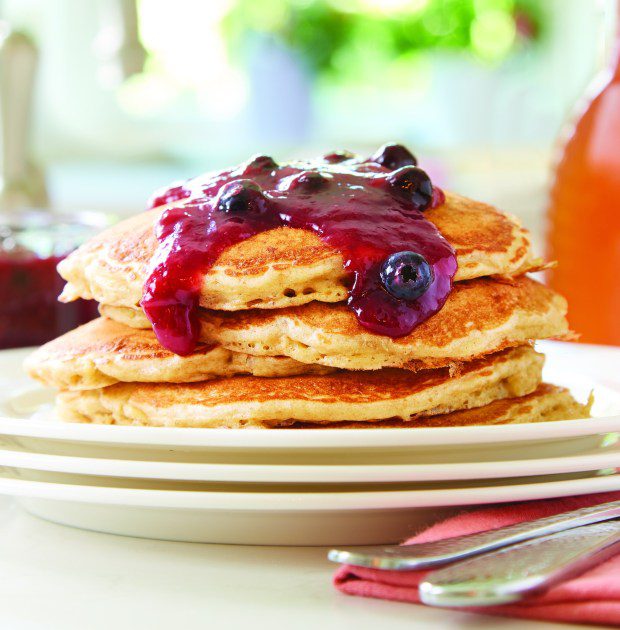
Oatmeal B&B Pancakes
The headnote says: “This recipe was given to me by my dad, the chief pancake maker in our house, where pancakes were a Saturday morning ritual. He first tasted them at a bed and breakfast in Vancouver, Canada, where he asked for the recipe. This is my slightly adapted version.”
Makes 12 pancakes
Ingredients:
1 cup old-fashioned oats
1 cup whole-wheat flour
2 tablespoons sugar
1 teaspoon baking soda
1 teaspoon baking powder
1 teaspoon salt
3 tablespoons butter, chilled
2 cups buttermilk
2 eggs
2 teaspoons vanilla extract
Vegetable oil
3 cups blueberries, divided
1 cup maple syrup
Directions:
In the bowl of a food processor with a metal blade, process oats 45 seconds. Add flour, sugar, baking soda, baking powder, and salt; pulse to combine. Sprinkle cold butter pieces on top, and process until mixture forms coarse crumbs. Transfer to a large bowl; make a well in center of mixture.
In a big glass measuring cup, mix together buttermilk, eggs and vanilla. Pour buttermilk mixture into the hole in the flour mixture and gently mix. (A few lumps are okay.)
Coat a large nonstick griddle or skillet with oil; heat to medium-high. Pour ¼ cup batter onto griddle for each pancake; cook until top is bubbly, and edges are a bit dry, about 2 to 3 minutes on each side.
While doing that, cook 1½ cups blueberries with maple syrup in a small saucepan over medium heat for 2 minutes. Mash cooked blueberries and strain syrup. Stir in remaining 1½ cups whole blueberries. Serve warm over pancakes.
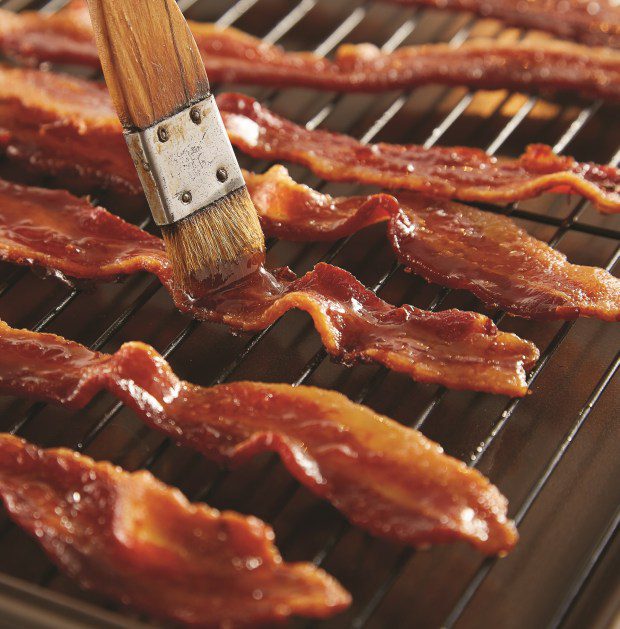
Maple Syrup-Glazed Bacon
The headnote states: “This sweet-salt-fat combination takes beloved bacon to greater heights. The neat and tasty technique makes bacon a stand-alone buffet item or a fun garnish for a Bloody Mary.”
Makes 12 pieces
Ingredients:
1 pound thick-sliced bacon
3 tablespoons maple syrup
Directions:
Heat oven to 350 degrees. Line a heavy rimmed half-sheet pan or jelly roll pan with aluminum foil.
Lay bacon flat on prepared pan. Bake 20 minutes. Remove cooked bacon to paper towels; discard bacon grease from baking sheet. Place an oven-safe cooling rack on baking pan. Place cooked bacon on rack, and brush one side lightly with maple syrup. Bake 10 minutes or until syrup has caramelized and bacon is cooked to desired crispness.
.
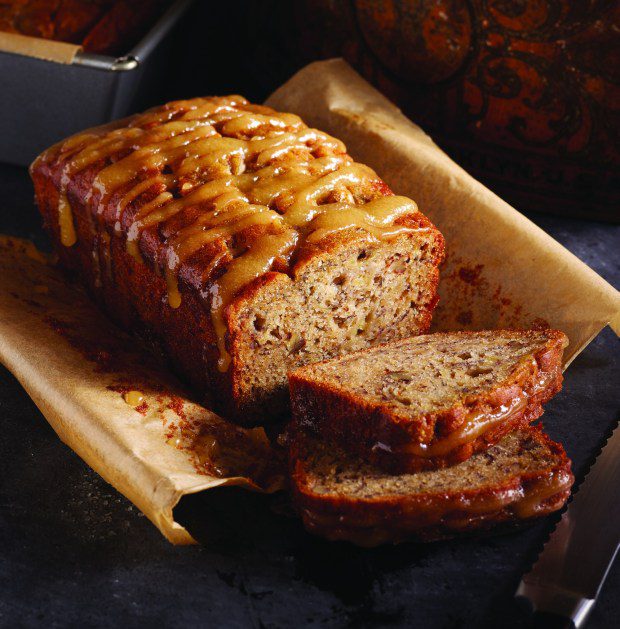
Best Maple Banana Bread
The headnote states: “This moist banana bread started as a recipe submitted to the Chicago Tribune. It has evolved over the years, and I have added a delicious maple glaze to make it even better. This is a great use for those overripe bananas that many of us keep in our freezers!”
Makes 6 mini-loaves or 2 (9-by 5-inch) loaves
Ingredients:
Bread:
3½ cups plus 1 tablespoon
All-purpose flour, divided
2 teaspoons baking soda
2 teaspoons baking powder
1 teaspoon ground cinnamon
2 cups chopped walnuts or pecans
2 cups light brown sugar, firmly packed
4 large eggs
1¼ cups canola oil
1 (8-ounce) container sour cream
1 tablespoon maple extract
3 cups (about 8 large) very ripe
Bananas, mashed with a fork
Glaze:
¼ cup butter
½ cup maple syrup
½ teaspoon maple extract
1 cup powdered sugar, sifted
Directions:
Preheat oven to 350 degrees. Lightly grease 2 (9-by 5-inch) loaf pans or 6 mini-loaf pans; line with parchment or wax paper.
To make bread, whisk together 3½ cups flour, baking soda, baking powder and cinnamon in a large bowl. In a medium bowl, toss nuts in the remaining 1 tablespoon flour.
Place brown sugar in the bowl of a stand-up electric mixer; add eggs, one at a time, mixing on slow speed until combined. With mixer running, add oil. Add sour cream and 1 table-spoon maple extract, mixing until combined.
Add half flour mixture to brown sugar mixture; stir in mashed bananas. Stir in remaining half flour mixture and flour-coated nuts. Pour batter into prepared pans, filling ¾ full; smooth tops.
Cook for 70 to 80 minutes (less for small pans) until bread puffs up and a toothpick inserted in center comes out dry. Cool down.
To create glaze, dissolve butter in a small pan over medium heat; stir in maple syrup. Stir while boiling for 2 minutes. Take off from heat; stir in ½ teaspoon maple extract. Add powdered sugar; mix until smooth. Stir 3 to 5 minutes or until mixture starts to thicken and cool slightly. Pour over bread.
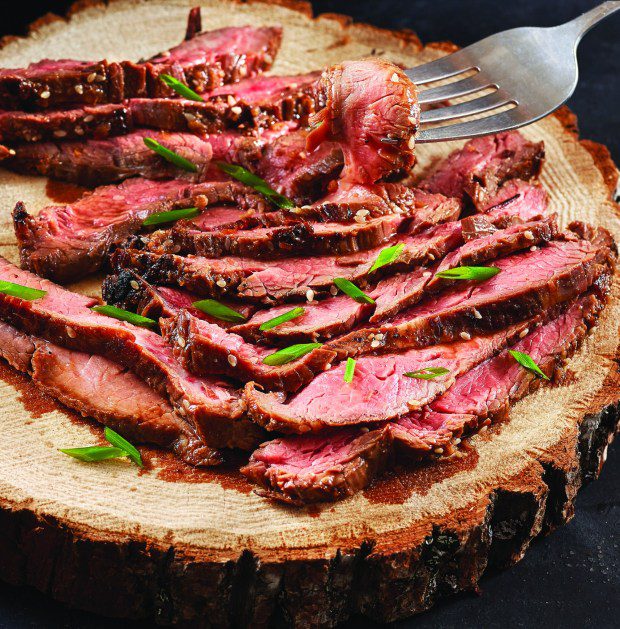
Maple-Teriyaki Marinade
The headnote says: “This marinade helps to tenderize meat, while giving it a sweet-salty onion flavor. It works nicely with skirt steak as well.”
Makes 1¼ cups
Ingredients:
1 tablespoon garlic
1 tablespoon fresh ginger
2 tablespoons minced shallots
½ cup tamari/soy sauce
½ cup maple syrup
2 tablespoons canola oil
2 tablespoons sesame seeds
1½ pounds flank steak
Directions:
In the bowl of a food processor with a metal blade, process garlic, ginger, and shallots until minced. Add soy sauce and maple syrup; pulse to combine. Slowly add oil, and process until emulsified. Add sesame seeds, and pulse once.
Transfer marinade mixture to a shallow glass baking dish or a zip-top plastic bag. Add steak and allow it to marinate for at least 30 minutes or up to 2 hours.
Heat grill or broiler to medium high. Grill or broil, 3 to 6 minutes on each side, or until tender and internal temperature reaches 135 degrees. Let steak rest 10 minutes; slice thinly against the grain before serving.
Recipes copyright by Corrine Kozlak and used with permission of Adventure Publications.
Stephen Fries is professor emeritus and former coordinator of the Hospitality Management Programs at Gateway Community College in New Haven, Conn. He has been a food and culinary travel columnist for the past 16 years and is co-founder of and host of “Worth Tasting,” a culinary walking tour of downtown New Haven. He is a board member of the International Association of Culinary Professionals. Email him at [email protected]. For more, go to stephenfries.com.





